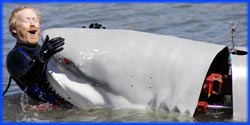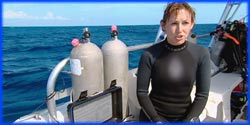


Premier Date: December 16, 2009
busted
To create a control sample, Adam and Jamie spread out 1,000 aluminum soda cans, cleaned the top surfaces of the cans, and released 40 rats to walk on them for 90 minutes. Viewing the cans under a black light clearly showed that many of them became contaminated with rat urine. Next, they collected 1,000 cans from a variety of locations across San Francisco. Viewing these cans under a black light revealed that most of them also had organic substances on them, but it was not clear what those substances were. To find out what was on the cans, Adam and Jamie took swabbed samples to UC Berkeley, where a mass spectrometer was used to identify the chemical compounds. As expected, the control contained 15 proteins that indicated rat urine. However, the test sample did not contain any compounds indicating rat urine. Furthermore, a professor of epidemiology at UC Berkeley explained that any dangerous viruses contained in rat urine would not survive on the exposed tops of aluminum cans.
confirmed
Adam and Jamie chose a total of 8 objects to test for cleanliness: toilet seat, money, kitchen sponge, hotel room remote, computer keyboard, light switch, cell phone, and shopping cart. They swabbed each surface for 10 seconds and created Petri dishes from the swabs that incubated overnight. Their first method of measurement was to count the number of microorganism colonies on each dish. They found that the toilet seat sample actually had the fewest colonies, while the kitchen sponge sample had more than they could count:
However, they always wanted to account for the “nastiness” or harmfulness of the types of organisms on each Petri dish, so they had a microbiologist re-rank the samples. The list was as follows.
Finally, Adam and Jamie decided they needed a larger sample size to provide better results. They enlisted a group of biology students at UC Berkeley to collect more samples from the top five dirtiest surfaces. After collecting and analyzing these samples, the final list was as follows.
busted
To test this myth, Tory, Grant, and Jessi built dug a 100 ft trench at the end of a test track and filled it with water. They did not have the means to use a Lamborghini, as shown in the movie, but settled for a car of similar size and weight. They equipped the car to drive by remote control and drove it off a small ramp at 50 mph. Rather than skipping, the car hit nose-first and flipped end-over-end. Grant explained that the stunt in the movie was likely achieved with a platform just under the surface of the water and with weights in the car to keep it level.
(This myth came from the movie Cannonball.)
confirmed
Tory, Grant, and Jessi again substituted an average car for a sports car, but equipped it with a nitrous oxide system to increase its top speed. Small scale tests showed that skipping worked better without a ramp, so no ramp was used for the full scale test. When the team drove the car onto the artificial lake, it skipped twice and continued driving on the other side.
Previous: Episode 134: Unarmed and Unharmed